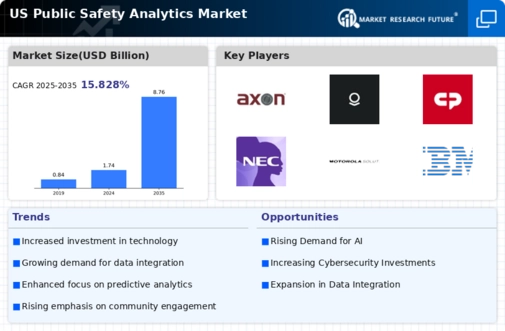Growing Demand for Real-Time Data Analysis
The public safety-analytics market is experiencing a notable surge in demand for real-time data analysis. This trend is driven by the increasing need for law enforcement agencies to respond swiftly to incidents. Real-time analytics enable agencies to process vast amounts of data from various sources, including social media, surveillance cameras, and emergency calls. According to recent estimates, the market for real-time analytics in public safety is projected to grow at a CAGR of approximately 15% over the next five years. This growth reflects the critical role that timely information plays in enhancing public safety outcomes. As agencies seek to improve their operational efficiency and effectiveness, the integration of real-time data analytics becomes essential in the public safety-analytics market.
Rising Investment in Smart City Initiatives
Investment in smart city initiatives is significantly influencing the public safety-analytics market. As cities across the US adopt smart technologies, there is a growing emphasis on integrating public safety solutions into these frameworks. Smart city projects often include advanced surveillance systems, IoT devices, and data analytics platforms that enhance situational awareness and improve emergency response times. The US government has allocated billions of dollars towards smart city projects, which are expected to create a robust demand for public safety-analytics solutions. This investment not only aims to improve urban living conditions but also enhances the capabilities of public safety agencies to prevent and respond to incidents effectively.
Advancements in Data Integration Technologies
Advancements in data integration technologies are playing a pivotal role in the evolution of the public safety-analytics market. The ability to consolidate data from disparate sources, such as criminal databases, social media, and emergency response systems, is becoming increasingly vital for public safety agencies. Enhanced data integration capabilities allow for more comprehensive analysis and informed decision-making. As agencies seek to leverage big data for improved outcomes, the market for data integration solutions is projected to expand significantly. This trend indicates a growing recognition of the importance of holistic data approaches in addressing public safety challenges.
Increased Focus on Crime Prevention Strategies
The public safety-analytics market is witnessing an increased focus on crime prevention strategies, which is reshaping the landscape of law enforcement. Agencies are increasingly utilizing data analytics to identify crime patterns and hotspots, allowing for proactive measures to be implemented. This shift towards prevention rather than reaction is supported by various studies indicating that data-driven approaches can reduce crime rates by up to 30%. As law enforcement agencies prioritize crime prevention, the demand for analytics tools that facilitate this approach is expected to rise. This trend underscores the importance of analytics in developing effective public safety strategies and enhancing community trust.
Legislative Support for Enhanced Public Safety Measures
Legislative support for enhanced public safety measures is a critical driver of the public safety-analytics market. Recent laws and regulations have been enacted to promote the use of data analytics in law enforcement and emergency management. These legislative frameworks often provide funding and resources for agencies to adopt advanced analytics technologies. For instance, federal grants have been made available to support the implementation of data-driven strategies in public safety. This support is likely to encourage more agencies to invest in analytics solutions, thereby expanding the public safety-analytics market. The alignment of policy with technological advancements creates a conducive environment for growth in this sector.






















Leave a Comment